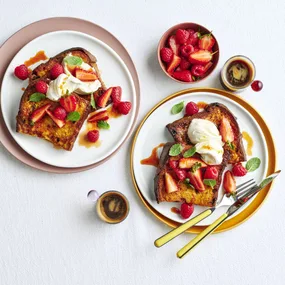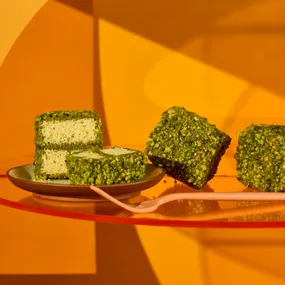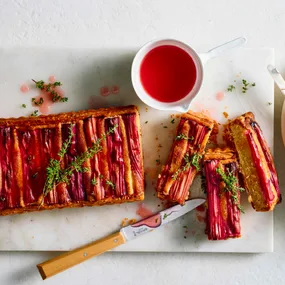The first sfogliatella I ever ate was at Carlo’s Bakery in Hoboken, New Jersey. We joined a queue and waited in the rain as white boxes lashed with red twine flew out the door of the bakery, which was heaving with a dizzying array of brightly coloured cakes and novelties. Of all the treats, the best were the cannoli and the sfogliatelle. The crunchiness of the pastry against the smoothness of the filling was so enticing. According to the guys with noble Italian blood in the kitchen, sfogliatelle are best eaten warm from the oven; their eyes rolled back as they spoke to convey the sheer pleasure of doing so.
Making the semolina custard is fairly straightforward. Note that brands of semolina vary a lot; for anything sweet use white, which comes from softer grains. If, after cooling, the custard is still too thick, stir in some milk or a little booze to soften it. It’s a versatile filling, and even better when you throw in a handful or two of dried or candied fruit.
Because it’s Easter, I’ve added chocolate to the filling in the form of cocoa powder. This tightens the mixture a little, especially if you use Dutch-process cocoa, but I like the intense flavour of this kind of cocoa and always choose it over other types. If chocolate isn’t your thing, omit it altogether and instead add a load of finely grated lemon rind and a few splashes of limoncello.
The trickiest part of making sfogliatelle is getting the dough thin enough – you should be able to read through it. Even using a commercial pastry roller, I found the pastry was too thick, but I picked up a trick from an episode of Cake Boss. The key is to have a large surface area to work on. Cover a large kitchen table with an old clean tablecloth that you don’t mind getting a little dirty (or, if you don’t have a suitable table, you can wing it and throw a piece of melamine on top of some milk crates, which is what we do at the shop). Roll out the dough as thinly as possible with a rolling pin, make yourself a cup of tea and, if you have helpers at hand, call in the troops (many hands make light work in this case).

Step 3.
(Photo: John Paul Urizar) (Credit: Photo: John Paul Urizar)Stretch and pull the dough as thinly as you can using the palms of your hands and pulling in an upward and outward motion, working from the centre and then around the sides until it’s evenly translucent – you’re after a square of tissue-paper-thin dough. Smear half the pastry with half the butter, then fold the unbuttered pastry over the top and spread with the remaining butter. With the shortest side facing you, roll the dough into a tight cylinder – I find using the cloth to help roll makes this much easier. The cylinder will be about 6.5cm in diameter. After a few hours in the fridge (you may need to cut it into two or three segments to fit) the fat solidifies, making the dough a lot easier to handle.
Once the cylinder is firm, slice it into 5mm-thick rounds and start working with one round at a time, keeping the rest in the fridge so they remain nice and firm. Using lightly floured hands, take a round of dough and push down into the centre with your thumb, working around the pastry with your fingertips to form a funnel shape – the sides should be about 4mm thick. Pipe some filling into the funnel-shaped pocket, making sure there’s enough room to pinch the edges of pastry closed to seal, and place on a baking tray lined with baking paper.

Step 7.
(Photo: John Paul Urizar) (Credit: Photo: John Paul Urizar)We love making the sfogliatelle at Easter, and after seeing that they’re called lobster tails in the States, they seem especially appropriate for a big fish Friday. You could prepare them the day before and bake them just before you serve them so they’re piping hot and you get the most out of the textures.
Ingredients
Method
Main
Knead flour, honey, 7gm fine salt and 175ml water in an electric mixer fitted with a dough hook on low speed until smooth, shiny and elastic (7-8 minutes). Wrap in plastic wrap and refrigerate for 1 hour to rest.
Roll out dough on a lightly floured work surface as thinly as possible (about 2mm thick), then fold into quarters.
Place a clean old sheet or tablecloth over a large central work surface, dust lightly with flour, then place dough on the cloth and unfold. Gently lift, pull and stretch the dough, using the palms of your hands facing upwards. Start at one edge and work your way around, pulling and stretching the dough into a paper-thin square that is evenly translucent enough to read through.
Smear half the dough with butter, fold the unbuttered dough over the top, then butter the top of the dough.
With the shortest side facing you, roll dough into a tight cylinder, using the cloth to help if needed, place on a tray, cover with plastic wrap and refrigerate until chilled and firm (about 2 hours), then slice into 5mm-thick rounds.
Meanwhile, for chocolate-semolina filling, whisk cocoa, cinnamon, 300ml water and a pinch of salt in a saucepan until smooth and combined, bring to the boil over medium-high heat, add semolina and whisk continuously until mixture is thick and no longer grainy (4-5 minutes). Remove from heat, whisk in eggs and sugar, then fold in ricotta, dried pear and amaretto, cover directly with plastic wrap and refrigerate until cooled (about an hour). Transfer to a piping bag fitted with a 1cm plain nozzle.
Preheat oven to 180C. Working with a round of dough at a time (keep the others refrigerated), push your thumb into the centre of the round and work around the sides, lightly pressing with your thumb and forefinger to form a funnel shape and thin the dough to about 4mm thick.
Pipe a little filling into the funnel, leaving about a 1cm space at the top, pinch edges together and place on a baking tray lined with baking paper and repeat with remaining pastry and filling. Bake, swapping and turning trays during cooking, until golden and crisp (12-15 minutes). Cool on trays for 5 minutes, then serve warm dusted with icing sugar and with melted chocolate for dipping.










